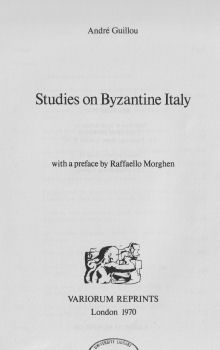- (Avars, Sklavenes and Bulgars - new eastern arrivals in
the Exarchate in the VII c. – first half of VIII c., i.e. up to the end of
Byzantine rule) 203
- (Plate II: Imperial plaque (Justinian’s II))
209
- (Other plates, III to XXVI)
213
- (Conclusion) 218
Plates:
Pl. II.
Imperial plaque (Justinian’s II) (Florence)
Pl. III.
Warrior on horseback (Rome)
Pl. IV.
Saddle ornaments (Rome)
Pl. V.
Boss of a shield (Rome)
Pl. VI.
Warrior on horseback (Florence)
Pl. VII.
Lombard reliquary (from Francovich, Il problema..)
Pl.
VIII. Lombard bracteate (from Cecchelli, I monumenti..)
Pl. IX.
Tuscania ambo (Rome)
Pl. X.
Aquileia plaque (from Francovich, Il problema..)
Pl. XI.
Cividale plaque (Venice)
Pl. XII.
Sirmione plaque (from Francovich, Il problema..)
Pl.
XIII. Bronze lamp (Rome)
Pl. XIV.
Bronze ewer (Rome)
Pl. XV.
Pyxis, a, Isaac sacrifice (Rome)
Pl. XVI.
Pyxis, b, Daniel in the den of lions (Rome)
Pl.
XVII. Earrings (Rome)
Pl.
XVIII. (a) Earring (Rome). (b) Earring (Rome)
Pl. XIX.
Earring (Rome)
Pl. XX.
Wedding ring (Rome)
Pl. XXI.
Brooch (Rome)
Pl.
XXII. Brooch (Rome)
Pl.
XXIII. Brooch (Rome)
Pl.
XXIV. Brooch (Rome)
Pl. XXV.
Bronze basin (Rome)
Pl.
XXVI. Bronze basin (Rome)
In a
recently published book, I set out to re-examine one of the most intensively
studied areas of Byzantine history, the province of Italy from the sixth to
the middle of the eighth century, using the techniques of the geographer,
the demographer, the statistician, the archaeologist, and the sociologist of
art (1).
To avoid
diversions in an inquiry which is by no means free of risk, I have taken as
my guide the somewhat Platonic definition, made by a cultivated man of
action of the sixth century, Cosmas Indicopleustes: Πᾶσα δὲ πολιτεία
ἀνθρώπων διὰ τέχνης καὶ ἐπιστήμης λογικῆς συνίσταται (2), i.e., every
civilization rests upon technical skill and reason. I have therefore
examined my chosen fragment of civilization by scrutinizing its artifacts.
Since my interpretation of the relevant objects differs from the accepted
one, it would be useful to remove them from the context in which they are
usually featured as evidence, so that I may list more precisely the details
of the technique which justify my characterization of these objects.
The
preliminary geographical study - geographical in the broad sense, of seeking
a social and economic as well as a spatial entity - determines the
geographical framework which supported this civilization, was given life by
it, caused it to produce its artifacts. This study reveals the existence of
a region which corresponded to a social entity: the Exarchate proper and the
Pentapolis (3). This region was formed around one large metropolis, Ravenna,
(*) This
article is based on a lecture delivered on 20th February 1969 at the
Dumbarton Oaks Center for Byzantine Studies. I am most grateful to my
colleague James Howard-Johnston for doing this English translation.
(1) A. Guillou, Régionalisme et indépendance dans l’Empire byzantin au VIIe
siècle. L’exemple de l’Exarchat et de la Pentapole d’Italie (Istituto
storico italiano per il Medio Evo, Studi storici, LXXV-LXXVI), Rome, 1969.
(2)
Topographie chrétienne, III, 75, ed. Wanda Wolska-Conus, I, Paris, 1968,
515 (Sources chrétiennes, XLI).
(3) See Guillou, Régionalisme et indépendance, 65-76; and the map of Pl. I.

202
which
was connected with the local centres by a good network of roads and by tight
administrative bonds; a powerful and alluring metropolis, which cast out a
traditional culture over the region, which absorbed and united educated men
and expressed the desires of the ordinary population.
If one
makes, like an archaeologist, a stratigraphic section of the population of
this region by using all available sources, one may distinguish three
layers: the bottom layer covers the sixth century, the middle layer, the end
of the sixth, the upper layer, the seventh century and half of the eighth,
that is, it extends up to the end of Byzantine rule. The statistics are as
follows: in the sixth century, 70 % Latins, 14 % Goths and 16 % easterners
(Greeks, Armenians, Persarmenians and Syrians), proportions which are based
only on 150 personal names, but which correspond precisely with those
obtained by the archaeological study of burials for the large towns of
northern Italy, for instance, Concordia and Aquileia (4). The easterners
were large landowners, soldiers, clergy, artisans, merchants, bankers,
sailors, officials, who had come from Syria, Thrace, Bithynia, Cilicia,
Armenia, Greece and had settled in Italy from the first century onwards;
Jews, too, who were involved in all professions but normally had no economic
power.
At the
end of the sixth century the proportions have altered: 50 % Latins, 7 %
Goths, 43 % easterners. This significant increase in the percentage of
easterners, that is those who were neither Latins nor Goths, an increase of
27 %, is easily explained. Belisarius, Narses and other Byzantine generals
had brought with them, as mercenaries and foederati, Isaurians, Thracians,
Illyrians, Persians, Armenians, Antes, Slavs and Bulgars, many of whom
probably did not return to their native country or their recruiting ground
at the end of the campaigns. The establishment of a Byzantine province in
the form of the Exarchate, with its own personality and considerable
administrative autonomy, attracted tax- collectors, officials who managed
the currency, the Post and granaries, and soldiers, too, who tended to
settle themselves after investing their savings in estates abandoned by lay
Latin owners who had been ruined by the Gothic administration and by
economic decline.
(4)
Leljlia Ruggini, Ebrei e Orientali nell’Italia Settentrionale fra il IV e
il VI secolo d. Cr., in Studia et documenta historiae et juris,
XXV (1959), 267-269 (Pontificium institutum utriusque juris).

203
No
absolute numbers can be suggested for this population at the end of the
sixth century, just as it is impossible to know the ratio of urban to rural
population. But its diverse origins do not seem to have prevented its
cohesion. Latins, Goths and easterners came together quite naturally before
a notary, for example when one of them needed the signatures of the others
as witnesses. Certainly some went to pray in the Arian cathedral, St.
Anastasis of the Goths, and others went to the basilica Ursiana. Thus, long
association in one area produced many everyday ties in this population. I
think that one may speak of some sort of assimilation among the ethnic
groups, since one can cite an example of intermarriage, at least at the end
of the sixth century (5).
(Avars, Sklavenes and Bulgars - new
eastern arrivals in the Exarchate in the VII c. – first half of VIII c.,
i.e. up to the end of Byzantine rule)
Lacking
the numerical evidence, which the devotees of the new quantitative geography
consider fundamental (6), one may think that the layer of population which I
have examined was uniform; but there were within it several sure signs of a
serious demographic decline. Such a general decline in the Mediterranean
basin is well known; but if one reads the narrative sources and at the same
time examines the prices of the chief foodstuffs (corn, wine, oil) and the
bullion value of the currency up to the end of the seventh century, one can
assert that the crisis was especially acute in Italy. The causes were
insecurity and fear, which made impossible to farm regularly or to maintain
the irrigation channels; military requisitioning and plundering by Goths and
Byzantine troops, natural disasters like the bubonic plague of 542-543,
epidemics which ravaged an ill-fed population in unhealthy regions.
This
demographic crisis halts at the end of the seventh century. I find that many
houses were rented at this time; houses scattered over the countryside
probably replaced the nucleated village - a sign of renewed security; large
estates were managed without disturbance. I would explain this security and
higher demographic level by an increased birth-rate, which followed the
period of political and economic crisis, and also by an influx of
population. For the proportions between ethnic groups have again altered:
(5) G. Marini, I papiri diplomatici raccolti ed illustrati, Rome, 1805, n.
122, p. 187.
(6) See
W. Warntz, Macroscopic analysis and some patterns of the geographical
distribution of population in the United States, 1790-1950, in W. L.
Garrison and D. F. Marble, Quantitative Geography, I, Evanston, 1967,
191 (Northwestern University - Studies in Geography, XIII): «It is possible
that some of the lag in the development of social science is due to attemps
to examine social change before understanding social equilibriums in the
primitive terms», that is, «the numerical portrayal» of all human society.

204
45 %
Latins, 5 % Goths, 50 % easterners. One must explain this further increase
of those who are normally called «Asiatics»; for, moreover, the Latin
population was increased at the beginning of the seventh century by a
certain number of Italian émigrés, who had fled the Lombards and the Slavs.
Who were
these new arrivals ? They were groups of Avaro-Sklavenes and of Bulgars, who
have left numerous traces in the place-names, which I found in Latin
archives dating from the eighth to the twelfth century (7); a few
place-names exist today. The Avaro-Sklavenes penetrated into the Exarchate
coming by land or over the lagoons from the North at the end of the sixth
century, and by sea before the middle of the seventh century from Dalmatia,
whence they had been driven by Croat tribes who installed themselves there
with the authorization of the Emperor Heraclius. The Protobulgars were those
who escaped massacre at the hand of the Franks and reached Italy with their
chief, Altzek, during the reign of Constans II. Extensive archaeological
work, which has been undertaken since the Second World War, particularly in
the countries of eastern Europe, has greatly modified our ideas of the
development of these peoples. The Avars, who made their final migration into
Italy, were still semi-nomads; but they were no longer raising only horses,
but cattle, sheep, pigs, and large numbers of poultry; and they were doing
the intensive farming which is required for raising these animals, perhaps
on a communal basis and with the help of slaves. They had arrived at the
notion of a territory commanded by one chief. They were excellent
goldsmiths; they knew how to work silver and bronze; they made, besides
arms, sickles, chisels, colanders, scissors for cutting cloth (8). The Sklavenes were farmers, accustomed to living along rivers, near lakes and
ponds; their huts were grouped in villages, which were connected by the
routes of communication; they were hospitable and jealous of their liberty;
they lived a communal life and were experienced sailors of rivers. They were
thus a people who had developed out a patriarchal, communal culture into a
tribal, communal culture, with no change in the strictly rural character of
(7)
Terra Bulgarorum (VIIIth-IXth centuries), S. Giovanni in Bulgaria
(1069), vicus Sclavinorum, vicus Bulgarorum (1085), vicus
Avarorum (XIth century), S. Pietro in Bulgaria, S. Gervasio in Bulgaria
(XIIth century): Guillou, Régionalisme et indépendance, 98-100.
(8) See
G. Laszlo, Etudes archéologiques sur l’histoire de la société des Avars,
in Archaelogia Hungarica, N. S., XXXIV (1955), passim, and especially
33, 37. 140.

205
their
society (9). The Protobulgars are the least known: they lived in fortified
towns, which consisted of a stone palace surrounded by mud huts, or in huts
which were hidden in the forests; they knew no literary language, save Latin
(10).
When one
considers the first contacts between the new arrivals of the seventh century
and the earlier inhabitants of the land, Latins, Goths and easterners, when
one asks how well did they live together thereafter, one must remember that
the implanting had two aspects: a physical one, where and how were they
settled, and an intellectual aspect, what level of cultural development had
they reached. We shall notice first that the Avars, Sklavenes and Bulgars,
who were received by the Byzantine authorities in the Exarchate, were
experienced fighting men, who could have been used against the Lombard
enemies, for example on the frontier along the river Panaro, where I have
discovered a place-name of Slavic origin, Bodena, translated in a
document by Aquaviva (11), or along other diagonal invasion routes.
Nevertheless, I believe that, like the neighbouring Lombard powers, the
Byzantine administration installed Slavs mostly in the hope of increasing
the numbers of farmers. The ties between the so-called barbarian tribes and
the native population must soon have become very close in the Exarchate, as
elsewhere: archaeology has shown that in Transylvania the fusion was
completed within two generations, roughly 50 to 60 years; the same happened
in the region of Thessalonica between the Greeks of Thrace, Avars, Sklavenes
and Bulgars, in Dalmatia between indigenous Latins, Slavs and Croats, and
lastly in Istria, where burial finds have proved that a considerable number
of free Slav settlers supplied the lack of agricultural labour and
barbarized, if one can use the term, the Latin minority (12).
Thus we
have a peaceful implanting after destructive migrations. Two obstacles might
have hindered such a fusion in the Exarchate, a fusion which resulted from
daily contact: religion and language, a basic spiritual framework and a
vital instrument for social life.
(9)
Guillou, Régionalisme et indépendance, 105.
(10)
Id., Régionalisme et indépendance, 106; St. Stancev Vaklinov,
L’Orient et l’Occident dans l’ancien art bulgare du VIIe au Xe
siècle, in Corsi di cultura sull’arte ravennate e bizantina, Ravenna,
1968, 241-254 (Università degli studi di Bologna, Istituto di antichità
ravennati e bizantine).
(11) Ed. Guillou, Régionalisme et indépendance, 270,1. 10 (752).
(12)
Id., Régionalisme et indépendance, 108.

206
The
Avars, Sklavenes and Bulgars, who installed themselves in the Exarchate,
were still pagan: they were animists; if we are to believe later sources,
they worshipped the god of thunder, rivers, nymphs, forests, lakes, birds,
fire, stars, the moon and the sun; but they believed in the immortality of
the soul, and had family cults of house spirits and lares (13). The most
cherished religious practices of seventh-century Byzantines were very
similar: in town as well as country one visited sorcerers and diviners; one
interpreted the shape or movement of clouds; one predicted the future; at
the new moon one danced round a fire; one swore by pagan divinities; one
sought from amulets and icons the cures which doctors had not given, if they
indeed were consulted; moreover, in Byzantine Italy, in large towns, priests
paid devotions to idols, and in certain regions peasants were mentioned who
worshipped forests, stones and trees: in certain cases the Byzantine
administration extracted money for authorizing these pagan sacrifices.
A
linguistic map of the Exarchate, if one could draw it, as of Asia Minor,
Macedonia or any other region of the Empire, would reveal a motley
collection of languages, which corresponded to the diverse ethnic groups
scattered there. In the countryside and even in Ravenna one could certainly
hear talk in Latin, Greek, Goth, Avar and the Sklavene and Bulgar dialects.
But the common language of the population was Latin, as it was during the
Gothic period. The officials and soldiers who were appointed at Ravenna knew
enough Latin, I suppose, to make possible preliminary contacts.
After
all, who knew Greek at Ravenna in the seventh century ? The following story,
told by the chronicler Agnellus, a family story, reveals the truth: in the
third quarter of the century, the Exarch Theodore’s notary died; and this
high Greek official was searching in vain for a competent man to replace
him; his confidants finally recommended a young man of excellent local
family, who was called Johannicis, a name which corresponds to the Greek
Ἰωαννίκης. The Exarch summoned him for a test, and snapped him up when he
found that he could translate an imperial letter at first reading from Greek
into Latin. The Exarch was disappointed only in that the young man had been
so poorly endowed by nature;
(13) L. Niederle, Manuel de l’Antiquité slave, I, 2, Paris, 1926 (Collection
de manuels publiés par l’Institut d’Etudes slaves), 129-138, 168.

207
he was
short and ugly (14). It is most likely that a man like Johannicis was a
great rarity in Ravenna.
Poetry,
chronicles, ecclesiastical works were written in Latin. The famous
Rotulus, which has recently been re-edited, was written in Latin; it was
a long poem composed for the Advent liturgy about the Incarnation of Christ,
a subject which preoccupied the whole Byzantine world in the seventh
century; when one reads it, one finds it hard which to admire more - the
clever versification or the purity of the traditional language of the Church
(15).
However,
there is another aspect to this culture. All the surviving notarial
documents, whether signed by high Byzantine officials or by private
individuals who were certainly prosperous and might have been Latin, eastern
or Goth, were written in Latin; but the language of these documents is no
longer the traditional literary Latin; it was a transition toward the
written Latin of the seventh century, which was filled with Greek
derivatives and constructions, the language of a milieu which doubtless knew
Greek but wrote Latin and intended to parade its Latin culture by quotations
from classical Latin poets and prose writers, a language which was
unfaithful to the classical tradition in both its morphology and its syntax.
It was a crude style of a mostly illiterate world; a world whose members can
be encountered as late as the ninth century, when the Byzantine
administration had long before departed from northern Italy a century and a
half before.
Nevertheless, these documents, of both the classicizing and the barbarizing
variety, are the product of a restricted milieu. Its vocabulary was that of
a narrow, governmental society; it adopted Greek terms for clothing, jewels,
lay and ecclesiastical offices and terms of biblical language. It was a
society which was also able to produce the moving funeral inscription in
Greek, in which the Exarch Isaac expressed all his affection for his
vanished young nephew, and which ends as follows:
Ἔκλαυσε
πικρῶς ἐκ βάθους τῆς καρδίας
Ὡς πρὸς
πατρὸς μὲν θεῖος αὐτοῦ τυγχάνων
Ἔχων δὲ
πρὸς αὐτὸν σπλάγχνα πατρ.κοῦ πόθου (16)
(14)
Agnellus, Liber Pontificalis ecclesiae Ravennatis, § 120, ed. O.
Holder-Egger, in Scriptores rerum Langobardicarum et Italicarum saec.
VI-IX, Hanover, 1878, 356-357.
(15) A
local culture of a high level since it also produced the famous series of
sarcophagi.
(16) The
best edition is that of Montfaucon, Diarium italicum, Paris, 1702,
98; see a drawing of the inscription in P.L., CVI, cols. 593-594. One
must compare the language of this text, which, in my opinion, has been
commissioned by the Exarch, with that of the bilingual funeral inscription
written on Isaac’s sarcophagus: the Greek text of the latter is rather
gauche, as is also the literal translation (βασιλέων is translated regum,
see below n. 42): ed. H. Dutschke, Ravennatische Studien. Beiträge zur
Geschichte der späten Antike, Leipzig, 1909, 11-12.

208
i.e.,
«Bitterly did he weep from the depth of his heart; he was his paternal
uncle, but he felt a father’s love and suffered a father’s loss».
This, I
believe, is an instance of imported culture, since in other respects one has
the impression that Greek was absent from this Byzantine territory, an
impression which very probably would be reinforced if monuments had survived
in the provincial centres. The population spoke Latin, but, whatever their
origin, they prayed to God for the salvation of the emperor in
Constantinople.
Religious monuments were likewise Latin. Archaeologists no longer speak of a
Byzantine origin for the buildings of Ravenna. The architecture of the
basilicas, of S. Apollinare in Classe, of S. Apollinare Nuovo, of S.
Giovanni Evangelista, derived from the Roman tradition; the mausoleum of
Theodoric or that ascribed to Galla Placidia, the baptisteries of the Arians
and of the Orthodox, the domed octagonal church of S. Vitale, were all built
in the fifth century or in the first half of the sixth, and they were all
built by local architects. Since the Gothic period they often imitated
Constantinople and adopted decorative or iconographic themes from the art of
the Greek capital: Christ, the two archangels, S. Vitale and bishop
Ecclesius in the apse of S. Vitale are instances of that; also the
processions of saints, prophets and apostles; finally, the small scenes
depicting the miracles and Passion of Christ against a gold background in
the three registers in the nave of S. Apollinare Nuovo - except that this
decoration dates from 526. Some eastern saints, Polycarp of Smyrna, Euphemia
of Chalcedon, Pelagia of Antioch, were recommended for the pious devotions
of the people of Ravenna; but the others were all African, Spanish or
Italian. The Magi scene in S. Apollinare Nuovo, was a western scene;
similarly, the allegorical representation of the Transfiguration in S.
Apollinare in Classe (from 549) was an archaic trait derived from the
Ravenna tradition, as was the fine figure of S. Apollinare orant, which
reminds one of the art of the catacombs.
A close
adherence to the local Latin tradition and a taste

209
for
introducing eastern decoration would have been natural when the patron was a
local Greek banker, as seems to have been proved, for example, for S.
Vitale. Above this local aspect of Ravenna culture of the sixth century, and
providing it with its context, there was an evident political propaganda of
the Byzantine administration, which has left its mark on the monuments. This
administration substituted their own claims to sovereignty for those of the
Ostrogoth kingdom by replacing, for instance, the procession of Theodoric’s
court in the lower register of S. Apollinare Nuovo, the palace church of the
Ostrogoth king, by a row of male and female saints. Such claims were
brilliantly expressed in the two votive panels of Justinian and Theodora in
S. Vitale. They were expressed in the seventh century by generous
concessions of considerable fiscal privileges to the church of Ravenna,
which had become the representative of local economic power, and I refer to
the heavily restored mosaic in the choir of S. Apollinare in Classe
(17).
(Plate II: Imperial plaque (Justinian’s II))
Such
sources, or products as I prefer to call them, left by the civilization of
the Exarchate, which I have hitherto used, now raise only few important
problems for scholars, whether archaeologists or students of written
material. This is not true of those which I shall now use. A few years ago,
in a remarkable article, a historian of Italian art, G. de Francovich,
reconsidered the best-known Lombard works of art; and by pushing a line of
argument, which others had begun (18), to its logical conclusion he
distinguished two categories among these works, one Lombard, the other not:
this category seemed to him to have a special character - in inspiration,
style and technique - which distinguished it both from Lombard and from
eastern products (19). This discovery has not, to my knowledge, been
disputed; but neither has any use been made of it, although it upsets
accepted general views about the art of the Italian peninsula in the early
Middle Ages and significantly increases the quantity of sources for the
civilization of the Exarchate.
(17)
Guillou, Régionalisme et indépendance, 85.
(18) P. Toesca, Storia dell’arte italiana, I, Il Medioevo, Turin,
1927, 270-285; A. Haseloff, La scultura preromanica in Italia,
Florence, 1930, 47-64; L. Karaman, Notes sur l’art byzantin et les Slaves
catholiques de Dalmatie, in Deuxième recueil Th. Uspensky, Paris,
1932, 338-351, and especially Bianca Maria Felletti Maj, Echi di
tradizione antica nella civiltà artistica di età longobarda in Umbria,
in Atti del II Convegno di Studi umbri (Gubbio, 1964), Peruuia. 1965,
317-341, who, unfortunately, does not know de Francovich’s paper.
(19) G.
de Francovich, Il problema delle origini della scultura cosidetta ‘Longobarda’,
in Atti del I Congresso internazionale di studi longobardi, 1951,
Spoleto, 1952, 255-273.

210
Since
these products removed from Lombard art seem to me to conform exactly to the
social structure which I believe I have discerned in the Byzantine province
of Italy from the sixth through the eighth centuries (20), I now turn to
look through the eyes of a Byzantinist from the vantage point of Ravenna at
some of these products, i.e., artifacts, of a civilization which reveal an
aspect not quite as refined as that which we have seen hitherto.
As I am
not a specialist in art history, my conclusions can only be considered a
hypothesis - a hypothesis, which is based on the examination of a few
objects which seem to me significant and which I use as a sample. The
hypothesis will, I hope, be confirmed by a general, specialized study of the
archaeological and artistic materials.
The
vital piece of evidence is, in my opinion, an object which is considered a
unique example of one sort of Lombard production in the seventh century, and
which is reproduced as such in textbooks and encyclopedias (21). It is a
small plaque, which is supposed to have decorated the helmet of a Lombard
military leader and to have represented the apotheosis of the Lombard king Agilulf, at the beginning of the seventh century. It is preserved in the
Bargello Museum in Florence. The ground for such an attribution was that
this piece of gilded copper was found in a tomb within the Lombard
dominions, near Lucca; in reality this proves nothing. The letters beside
the head of the enthroned personage have been read as D(ominus) N(oster)
or Domini Nostri, Agilulfus or Agilulfi (22;
Pl. _II_).
Embarrassed by the quality of the workmanship, some scholars have concluded
that it shows Byzantine influence (23), others, that a workshop survived
under the Lombards, faithful to the Roman tradition (24). But the
symmetrical composition around a central axis, as for example in the hunting
scene and the scene of a city’s surrender, which appears also on the casket
at Troyes, is typically oriental (25);
(20)
Guillou, Régionalisme et indépendance, 147-202.
(21) I
cite, as examples, Toesca, op. cit., 274-275 and fig. 167, Enciclopedia
italiana, s.v. «Agilulfo».
(22) Cfr.
Pl. II. Dimensions: mm 183 X 67.
(23) For
instance, Toesca, op. cit., 275.
(24) For
instance, Kl. Wessel, Monographische Bemerkungen zur Agilulf-Platte,
in Festschrift Johannes Jahn zum XXII. November 1967, Leipzig, 1967,
65.
(25) See
G. de Francovich, Il concetto della regalità dell’arte Sasanide e
l’interpretazione di due opere bizantine del periodo della dinastia macedone,
in Arte lombarda, IX (1964), 1-19. One should read the whole of this
article, which makes an important contribution to the knowledge of the
imperial imagery (adventus imperatoris, imperial hunt).

211
while
the two crowns, which are carried by the representatives of subjected
cities, are Lombard crowns; fortunately one such crown has survived for us
in Italy, found in Giulianova near Ancona; it is decorated, but with human
or animal figures which have very few connections with reality (26). The
theme of the conquered offering up the city to the conqueror has long been
familiar in the art of Constantinople, as, for instance, on the column of
Arcadius (27); the towers, representing the subjected city, are, for
example, like those of the Dumbarton Oaks pyxis (dating from the sixth
century) (28); counterparts of the two winged victories, carrying here the
labarum with the inscription VICTVRIA, are found already in the art of
classical Greece (29). The emperor without crown does appear on Byzantine
coins (30); seated on a throne, his feet resting on a footstool, he receives
the conquered with the gesture of speech (31); the two spathars flanking him
carry round, embossed shields and lances, and plumed helmets, which are
mentioned in Byzantine military tactical works (32).
(26) See
a good photograph in E. von Ubisch and O. Wulff, Ein Langobardischer Helm
in königlichen Zeughause zu Berlin, in Jahrbuch der königl.
preussischen Kunstsammlungen, XXIV (1903), fig. 2 and a separate colour
plate, and for other helmets the study of P. Post, Der kupferne
Spangenhelm. Ein Beitrag zur Stilgeschichte der Völkerwanderungszeit auf
waffentechnischer Grundlage, in Deutsches archäol. Institut. Römisch-germ.
Kommission, 34. Bericht (1954), 115-150.
(27) See
A. Grabar, L’empereur dans l’art byzantin, Paris, 1936, 54-57
(Publications de la Faculté des Lettres de Strasbourg, LXXV).
(28) See
W. Fr. Volbach, Frühchristliche Kunst, Munich, 1958, fig. 236, top
left.
(29) It
is known that this winged victory and the legend Victoria Aug.
disappear from the Byzantine coins during the first reign of Justinian II
(685-695): cf. J. Breckenridge, The Numismatic Iconography of Justinian
II, New York, 1959, 47-49 (Numismatic Notes and Monographs, CXLIV). On
the reverse of a sesterce of Trajan, the winged victory is standing and
presents a disc (a shield ?) inscribed VIC. DAC, which is supported
by a column (cf. for instance, A. Bellinger and Marjorie Alkins Bellincourt,
Victory, as a coin type, New York, 1962, pl. XII, 3 [Numismatic Notes
and Monographs, CXLIX]; it is a common motif on Roman imperial coins; one
can find examples in H. Cohen, Description historique des monnaies,
ΧΧ/7, Paris-London, 1888; the labarum is the emblem of the triumphant
general, it is often held by the emperor from the fourth century; see, for
example, Cohen, op. cit., VII, 420, no 111; one should note that the
labarum of our plaque is that of the archangels Michael and Gabriel on
either side of the apse of S. Apollinare in Classe (Fr. W. Deichmann,
Frühchristliche Bauten und Mosaiken von Ravenna, Baden-Baden, 1958, fig.
402, 403).
(30)
Admittedly, on coins, examples are rare: see W. Wroth, Catalogue cf the
Imperial Byzantine Coins in the British Museum, I, London, 1908, pl.
XXVII, nos 11, 12, 13, 14, etc. (Heraclius). One should note that the hair
style is shaped like that of Christ on the reverse of Justinian’s II coins
(cf. Breckenridge, op. cit., pl. V, 30), but one should also remember that
Theodoric, King of the Ostrogoths (495-535), was represented with a similar
hair style: cf. P. E. Schramm, Herrschaftszeichen und Staatssymbolik,
Stuttgart, 1954, pl. 14 (Schriften der Monumenta Germaniae Historica, ΧΙΙΙ/1).
(31)
This gesture has been interpreted by H. P. L’Orange, Iconography of
Cosmic Kingship, Oslo, 1953, cf. especially 171-183.
(32)
Pseudo-Mauritius, Strategikon, ed. J. Sheffer, Uppsala, 1664, 20.

212
All
elements of this scene can be found on the column of Arcadius (33); but the
last votive offering of barbarians, known today, is that on the Barberini
diptych of the sixth century (34). I find that the labarum, as emblem
of imperial victory, was no longer used in the seventh century, i.e., no
longer used in Constantinople (35). There is another oddity about this
object: the bearded emperor, who has Byzantine imperial slippers on his
feet, seems to be wearing trousers, which are no part of the imperial
costume: one may perhaps explain them as a false reading of the seated
figure’s imperial chlamys, which was pressed in by the loros (36); only a
provincial craftsman would have made such a mistake. Another oddity: the
seated figure holds in his left hand a short, sheathed sword, which rests on
his left knee, a sword with a little guard and hilt; this sword does not
resemble any surviving Lombard or Frankish swords (37); and one may observe
that a short sword is held by the enthroned Sassanid emperor, but between
his legs - as the one symbol of his power (38) - and that it reappears in
the left hand of the Emperor Basil II who is standing in military costume in
the eleventh-century Psalter of the Marciana (39). Another oddity: the
figures carry the crowns of the conquered on small cushions, in the western
manner (40). In conclusion, style and technique of the plaque demonstrate
that it cannot be Lombard; everything connects it with official Byzantine
imagery. The heavy-handed execution, certain archaic traits and other traits
which can only be explained by provincial manufacture seem to me to entail
an attribution to a provincial workshop, influenced by Constantinople as
regards the theme and composition, and connected with a Latin province,
(33) See Grabar, L’empereur dans l’art byzantin, 54-55 and pls. XIV and XV.
(34)
Ibid., 55-56.
(35)
Ibid., 168.
(36)
This ingenious interpretation was suggested to me by my colleague Mrs Doula
Mouriki - I am most grateful to her; cf., for example, R. Delbrueck, Die
Consulardiptychen, Berlin-Leipzig, 1929, volume of plates, pl. 21:
Anastase, 517 (Studien zur spätantiken Kunstgeschichte).
(37)
Cf., for example, E. Salin and A. France-Lanord, Rhin et Orient, II: Le
fer à l’époque mérovingienne. Etude technique et archéologique, Paris,
1943, 116-119.
(38) One
example on a silver dish, preserved in the Hermitage Museum, representing Chosroes I (531-578) among four dignitaries; cf. K. Erdmann, Die Kunst
Irans zur Zeit der Sasaniden, Berlin, 1943, pl. 67.
(39) Cf.
I. Sevčenko, The illumination of the Menologium of Basil II, in
Dumbarton Oaks Papers, XVI (1962), pl. 17.
(40) I
have in mind the early Christian sarcophagi which represent the oblatio
of the Magi: cf., for example, G. Wilpert, I sarcofagi cristiani antichi,
Rome, 1929-1936, pls. 96, 166 (4), 178 (1), 179 (2), etc., and, for a very
clear example of a possible model, pl. 219 (1). In some cases it is not
clear whether the Magi in fact carry cushions, but the objects in their
hands could have been interpreted as cushions by the engraver of the plaque.

213
particularly since the inscription near the head of the enthroned figure, in
a manner well-known in the Byzantine Empire (41) but unknown in the Lombard
kingdom, is written in Latin. In my opinion, it should be read vertically
and in the following way:
BA (sign
of abbreviation), for BA(sileus)
IVCTIN,
for IVCTIN(ianus) (42).
As the
word basileus first appeared among the official imperial titles in
629, this plaque probably represents Justinian II (43) accepting the
surrender of conquered Lombards; there is no need to ask whether a
particular event is commemorated, for this was an image used by imperial
propaganda of which there were probably several examples; it was probably
meant to be attached to a casket by rivets, the holes of which are visible,
and to be followed or preceded by other scenes on the other sides of the
casket.
(Other plates, III to XXVI)
We find
this same clientele with military tastes, this same workmanship and
technique of manufacture, in a fragment of carved ivory (44;
Pl. _III_)
representing an armed cavalryman on horseback, holding a lance and wearing a
plumed helmet. This object too must have come from a casket. It was found in
a seventh-century tomb in Nocera Umbra (E. of Perugia, region Umbria), on
the military Byzantine road going from Fano to Rome. Two other objects were
found on the same site: a gold decoration for a saddle, of which the central
piece bears a Greek monogram (45; Pl. _IV_);
(41)
See, for a very ancient example, E. Coche de la Ferté, L’Antiquité
chrétienne au Musée du Louvre, Paris, 1958, 10, no 5 (Vth century) and
p. 87.
(42)
This reading was suggested to me by the identification of the first letter,
which is surely a B rather than a D. The abbreviation βα for βα(σιλεύς) is
known from the earliest surviving official Greek documents of the beginning
of the XIth century (see the protocols of the imperial chrysobulls of the
XIth century, transcribed by F. Dölger, Die Entwicklung der
byzantinischen Kaisertitulatur und die Datierung von Kaiserdarstellungen in
der byzantinischen Kleinkunst, in Byzantinische Diplomatik, Ettal,
1956, 144), and can, therefore, be considered very ancient. It is also found
in the legends in Latin on coins (cf., for example, W. Wroth, Catalogue
of the Byzantine coins, II, London, 1908, p. 416 and pl. XVLIII, 9:
tremisses of Michael II at the beginning of the IXth century). There was no
Latin equivalent of this title known at Ravenna in the middle of the VIIth
century; for βασιλεύς is wrongly translated by rex in a funeral
inscription of the Exarch Isaac (see above n. 16 and the article mentioned
in the following note). And this, in my opinion, explains why, at Ravenna,
during the reign of Justinian II, βασιλεύς was simply transcribed basileus.
Cfr. Pl. II.
(43) See
L. Bréhier, L’origine des titres impériaux à Byzance, βασιλεύς et
δεσπότης, in Byzantinische Zeitschrift, XV (1906), 172-173.
(44) See
Pl. III. (Rome, Museo dell’Alto Medioevo; provenance: Nocera Umbra, tomb
59).
(45) See
Pl. IV, top (Rome, Museo dell’Alto Medioevo; provenance: Nocera Umbra, tomb
5). Such monograms inclosed within «boxes» are datable to the VIth century;
this one is like those discovered in St. Polyeuktos at Sarachane (see C.
Mango and I. Sevčenko, Remains of the Church of St. Polyeuktos at
Constantinople, in Dumbarton Oaks Papers, XV (1961), 246 and fig. 13,
for which it has been impossible to suggest a reading, and like the
Byzantine «hallmarks» incised on silver vessels: see Erica Cruikshank Dodd,
Byzantine Silver Stamps, Washington, 1961, Table I (Dumbarton Oaks
Studies, VII). I am most grateful to my colleagues C. Mango and I. Sevčenko,
who helped me with their expertise.

214
and the
boss of a shield (46; Pl. _V_), similar to those in the hands of the spathars on the plaque, which I consider to belong to the time of Justinian
II, probably representing an infantry battle above a decorative band of
acanthus leaves which rests on a braided border.
One may
attribute a similar provenance for a damaged gilded bronze plaque which is
now preserved in the Bargello Museum (47; Pl. _VI_) : the charging warrior
with a lance shows a technique which is known from the plaque of Constans
II, preserved in the Hermitage Museum (48); the style recalls that of some
Coptic or Sassanian textiles. This object too cannot have been of Lombard
manufacture, as was thought until recently (49); for Lombard productions
reveal an exclusive taste for abstract designs (50), a taste which they took
over from the inhabitants of the steppes. Two examples of this Lombard taste
will be adequate to prove here the truth of this: one side of the reliquary
in the Coire cathedral in the Grisons, in Switzerland (51;
Pl. _VII_), and a
gold bracteate, preserved in the Cividale Museum, which represents a warrior
on horseback (52; Pl. _VIII_). Many others could be cited
(53).
On the
same grounds of technique, and in particular on account of the style of
composition, one should now attribute many other objects to workshops in the
Exarchate and doubtless in Ravenna itself: the closely related Tuscania
(54; Pl. _IX_) and Aquileia
(55; Pl. _X_) ambo plaques,
(46) See
Pl. V (Rome, Museo dell’Alto Medioevo; provenance: Nocera Umbra, tomb 1).
(47) See
Pl. VI.
(48) See Delbrueck, op. cit., pl. 57.
(49) See
J. Baum, La sculpture figurale en Europe à l’époque mérovingienne,
Paris, 1937, 61, 76; another copy of this object (dimensions: mm. 100 x 75)
is preserved at Berne (Bernisches Historisches Museum, no 14492); see Baum,
op. cit., pl. XII, 24.
(50) As
de Francovich proved in his masterly article : Il problema etc., in
Atti del 1 Congresso internationale di studi longobardi, 1951,
Spoleto, 1952, 255-273.
(51) See
Pl. VII. One should note the lack of symmetry in the decoration and its
disorderly appearance.
(52) See
Pl. VII_. One should observe, as in the above note, the disorderly design
inside the framework, and the highly schematic representation of the
horseman.
(53) A first list can be found in the article of de Francovich: cf. n. 50.
(54) S.
Maria Maggiore, ambo; see Pl. IX.
(55) See
Pl. X. The composition in squares framing circles is known around the
mid-sixth century in Cyrenaica, for example (R. M. Harrison, A
Sixth-Century Church at Ras el-Hilal in Cyrenaica, in Papers of the
British School at Rome, XXXII, 1964, pl. V, b, from the second or third
quarter of the sixth century). The decoration is obviously oriental: the
palmettes, which decorate the corner-triangles, are those of several
capitals – of St. Polyeuktos at Sarachane (Istanbul) (R. M. Harrison and N.
Firatli, Excavations at Sarachane in Istanbul. Fourth Preliminary Report,
in Dumbarton Oaks Papers, XXI, 1967, 276 and fig. 14), in the Cairo
Museum (ibid., fig. 68), on the northern and southern ends of the facade of
S. Marco in Venice (which perhaps came from St. Polyeuktos: see Harrison and
Firatli, 276), of S. Vitale at Ravenna (Deichmann, op. cit., figs. 297, 301,
303, 304), and also on the arch of the ciborium of John VII (705-707) at S.
Maria Antiqua in Rome (P. Romanelli and P. J. Nordhagen, S. Maria Antiqua,
Rome, 1964, pl. 9 b); the technique of their carving, as well as the
stylized leaves flanking the palmettes, which together recall the
traditional canthari, reappear in the monuments cited above; the triangular
bunches of grapes, hung on leaves which are not vine leaves, are also known
in sixth-century Constantinople (A. Grabar, Sculptures byzantines de
Costantinople (IV-Xe siècle), Paris, 1963, pl. XXV, 2 (Bioliothèque
archéologique et historique de l’Institut français d’archéologie d’Istanbul,
XVII); they will be imitated at St. Gregory in Boeotia at the end of the
ninth century (Grabar, ibid., pl. XLIII, 3, 4); leaves stylized in the same
way, with bunches of grapes filling the voids, recur again in the twelfth
century, when they form an independent type of decoration inside gold icon
frames (see, for example, Kl. Wessel, Die byzantinische Emailkunst vom 5.
bis 13. Jahrhundert, Recklinghausen, 1967, no 55, p. 176). The carved
decoration of the frame and its plaitwork, recur for example on the
fragments of the ambo of Serres, which were attributed to the ninth century,
but were inspired by much older models (Grabar, ibid., 86-87 and pl.
XXXVIII, 3). I am most grateful to my colleagues Mrs Nancy Sevčenko and R.M.
Harrison, who suggested several of the comparisons used in this note.

215
the very
fine plaque from the chancel of Cividale (56;
Pl. _XI_), which was long
considered one of the finest pieces of Lombard sculpture and which resembles
Byzantine ivory work by so many traits, and the plaque from Sirmione in the
province of Brescia (57; Pl. _XII_), which, for the choice of motifs, seems
a counterpart of it.
One
should make a similar attribution for certain other objects, chiefly because
they were found in one of the tombs at Nocera Umbra, like the saddle
decorations and the ivory fragment with a horseman. I will present here only
three of them:
(56) See
Pl. XI. One should first note the perfect symmetry of the composition. The
plaited cross, which stands over the tree of life, the two candelabra raised
on three steps (as the cross on the reverse of the coins of Justinian II),
the lower cross decorated with stylized leaves (see the previous note for
the technique), the three symbolic animals which flank it (the lower two
recur for example on a plaque which was re-used in the South wall of the
Treasury of S. Marco at Venice: see O. Demus, The Church of San Marco in
Venice, Washington, 1960, fig. 25 (Dumbarton Oaks Studies, VI); the
lions recur on a chancel plaque, ibid., fig. 30), the bunches of grapes, the
ivy leaves which decorate the circles containing the symbols of the
Evangelists - these are all symbolic ornamentation, which was familiar to
sculptors in the East (see, for example, Grabar, Sculptures byzantines de
Constantinople, passim.). The four winged animals of the Apocalypse are
the four Evangelists, as it is attested by the inscriptions which they bear:
eagle-John, man-Matthew, bull-Luke, lion-Mark; the symbolism derives from
the early Christian period, perhaps from the second century, as C.
Nordenfalk, An Illustrated Diatessaron, in The Art Bulletin, L
(1968), 130-137, boldly suggests, who unfortunately knows nothing of
Augustine’s commentary (P.L., XXXIV, col. 1046), which might have made him
somewhat sceptical of the stemma which he believed could be drawn from the
various personifications of the four animals and their eastern or western
character. In the fifth century, Augustine knew of two interpretations:
St-Jerome’s, eagle-John, man-Matthew, bull-Luke, lion-Mark; and a second,
which he preferred, eagle-John, lion-Matthew, bull-Luke, man-Mark; and there
was another, older interpretation, that of St. Irenaeus (end of the second
century), lion-John, man-Matthew, bull-Luke, eagle-Mark, and this was often,
but not always, that of the Greek East. Our plaque has Jerome’s
interpretation, which Augustine rejected. Such were the three
interpretations; I do not think that one can draw any conclusion from this.
(57) See
Pl. XII.

216
a bronze
lamp (58; Pl. _XIII_), a cult object that is but one among many examples for
which a Syrian origin has been suggested (59); a bronze ewer, the pattern of
which is, perhaps, Sassanian (60; Pl. _XIV_); and an ivory pyxis
(61), which
is one of a group of known pyxides from the early Byzantine period, all
datable perhaps to the sixth century, and nearly all discovered in the West
(62). The first scene on the pyxis represents the sacrifice of Isaac; the
second, Daniel in the den of lions (63; Pl. _XV and
XVI_) - doubtless of
eastern iconography (64), but one should note that this type of object was
especially valued in the West (65) and that the execution reveals a
crudeness which would not appear in the products of workshops in
Constantinople or Alexandria, which were very experienced at working with
ivory.
I
suggest that these objects, and the Tuscania ambo, the chancel plaques of
Cividale, Aquileia and Sirmiohe, and Bobbio and others too, were made not in
Lombard workshops, but at Ravenna.
And now,
this Nocera Umbra pyxis - which may have had a lay use (66) - allows me to
turn to a group of objects which were intended exclusively for lay use:
jewels and household utensils.
(58) See
Pl. XIII (Rome, Museo dell’Alto Medioevo; provenance: Nocera Umbra, tomb
30).
(59) Cf.
M. C. Ross, Catalogue of the Byzantine Early Mediaeval Antiquities in the
Dumbarton Oaks Collections, I: Metalwork, Ceramics, Glass, Glyptics,
Washington, 1962, nos 32, 35, 36 and especially 34. For an identical bronze
lamp of unknown provenance, with a ring and a bird (?) for lifting the top
to pour in oil, see P. R. Garrucci, Storia dell’arte cristiana, VI,
Prato, 1880, pl. 468, fig. 5.
(60) Pl.
XIV: Nocera Umbra, tomb 17 (= Rome, Museo dell’Alto Medioevo). Cf. A. Pasqui,
in Monumenti Antichi, XXV (1919), 197-198 and fig. 45, who by mistake
says that it is a silver vase; height 180 mm. The shape is that of a bronze
Persian vase preserved in the Herat Museum (cf. R. Ettinghausen, The Wade
Cup in the Cleveland Museum of Art, in Ars Orientalis, II, 1957,
332 and fig. 36). The decoration with palmettes and ivy leaves cannot have
been of Lombard origin; cf. J. Werner, Italisches und koptisches
Bronzegeschirr des 6. und 7. Jahrhunderts nordwärts der Alpen, in
Mnemosynon Theodor Wiegand, München, 1938, 83 and fig. 28, 1.
(61) W.
Fr. Volbach, Elfenbeinarbeiten der Spätantike und des frühen Mittelalters,
Römisch-germanisches Centralmuseum zu Mainz, Katalog, VII, Mainz, 1952, no
164, p. 78.
(62)
Volbach, ibid., 77-89.
(63) See
Pl. XV and XVI (Rome, Museo dell’Alto Medioevo; provenance: Nocera Umbra,
tomb 39).
(64) Cf.
I. Speyart van Woerden, The Iconography of the Sacrifice of Abraham,
in Vigiliae Christianae, XV (1961), 229.
(65) At
least to judge by the overwhelming proportion found in the West. It was
hitherto thought that the pyxides had a liturgical purpose (for the Host, or
for relics), considering the iconography of almost all of them (see Volbach,
Elfenbeinarbeiten, 77, and Dictionnaire d’archéologie chrétienne
et de liturgie, s.v. «Pyxide»). But the provenance of the Nocera Umbra
pyxis, which came from a soldier’s tomb, seems to suggest that it was used
by a layman. It does not seem to me that a religious iconography conflicts
with this, since such iconography was very generally used (Guillou,
Aspects de la civilisation byzantine, in Annales, XXIV, 1969, in
the press). If one admits that our pyxis and certain others were
manufactured in Ravenna, one must asks where did the ivory come from.
(66) See
the previous note.

217
A group
of gold earrings, decorated with garnets: two, found in a Nocera Umbra tomb
(67; Pl. _XVII_), have the design of seated birds, and one should also note
the decoration in gold thread (filigree), which was frequently used in
Byzantine jewelry (68); three come from a tomb at Castel Trosino near Ascoli
Piceno (region Abruzzi) and the frontier of the Byzantine Pentapolis
(69; Pl. _XVIII a, b, Pl. XIX_). A wedding-ring, again from Castel Trosino
(70; Pl. _XX_). Three gold brooches from Castel Trosino - one
(71; Pl. _XXI_)
decorated with an old cameo in the centre and garnets, while the other two
are of very delicate workmanship with a rich embellishment of gold thread
(72; Pl. _XXII, XXIII_). Other jewels of the same type are known from other
parts of the Empire and from outside; for instance, the analysis of the
bronze cores of jewels from certain seventh-century barbarian tombs in
eastern France proves that they are imported objects (73). Finally, a gold
brooch from Nocera Umbra is more classical in design; in the centre one can
discern the bust of a woman whose hair is done according to an entirely
Roman tradition; the double beaded border which surrounds her derives from
the same tradition (74; Pl. _XXIV_).
I think
I may say that all these objects bear some resemblance to each other. This
would be more obvious if one were to add to my sampling other sculptures
which have hitherto been considered Lombard but which are not,
(67) See
Pl. XVII (Rome, Museo dell’Alto Medioevo ; provenance : Nocera Umbra, tomb
164).
(68)
See, for example, the decoration of the frame of the big cameo of Honorius
and Maria in the Ed. de Rotschild collection (L. Bréhier, La sculpture et
les arts mineurs byzantins, Paris, 1936, pl. XVI), and that of the
twelfth-century gold medaillon (Wessel, Die byzantinische Emailkunst,
no 44), etc.
(69) See
Pl. XVIII a, b, Pl. XIX; one finds the same decoration in gold thread,
considered in the previous note.
(70) See
Pl. XX (Rome, Museo dell’Alto Medioevo).
(71) See
Pl. XXI (Rome, Museo dell’Alto Medioevo; provenance: Castel Trosino, tomb
16).
(72) See
Pl. XXII, XXIII (Rome, Museo dell’Alto Medioevo ; provenance : Castel
Trosino, tomb 16).
(73)
These brooches, found in different sites beside clearly «barbarian» objects,
are attributed to Byzantine art and associated with the numerous jewels
which came to Gaul or Germany directly from Constantinople or Italy (E. Salin, Le Haut-Moyen-Age en Lorraine d’après le mobilier funéraire. Trois
campagnes de fouilles et de laboratoire, Paris, 1939, 144, 146, 147-151,
and pl. XVII, 6, 7, 8 a and b). A similar analysis should be done of the
jewels and metal objects found in «Lombard» tombs in Italy; it should
corroborate my attributions. The jewels found in France are dated to the
second half of the sixth century; and one knows that the Lombard tombs are
dated (from the coins) to the beginning of the seventh century. The evidence
is therefore consistent.
(74) See
Pl. XXIV (Rome, Museo dell’Alto Medioevo; provenance: Nocera Umbra, tomb
39). One should compare the head of a fifth-century Empress, preserved in
the Castello Sfor- zesco in Milan (Volbach, Frühchristliche Kunst,
pl. 68), and that of St. Anne in S. Maria Antiqua in Rome (Romanelli and
Nordhagen, S. Maria Antiqua, pl. 19).

218
and
other jewels found in Lombard tombs or preserved in museums, which are quite
distinct from true Lombard products. A complete inventory will have to be
made by archaeologists (75).
One
should add to this group some of the bronze basins found in Lombard tombs in
Italy, two of which come from Castel Trosino (76;
Pl. _XXV and XXVI_).
Others penetrated as far as England, Spain, along the Rhine, and Central
Europe. They were long thought to be of Coptic manufacture, but twenty years
ago German archaeologists restored part of them to the Exarchate; Byzantinists, however, have made no use at all of this discovery
(77).
(Conclusion)
All
these objects were produced in considerable quantities and are of a
significant quality. They are distinct from Lombard products in that they
represent real figures and show respect for the true lines of the subject,
for composition and for symmetry. It was a classical heritage, perhaps a
local heritage; it felt the influence of the East and it revealed vivacity
and dynamism, which taken together formed its originality.
It was
the art of a tightly-knit social group, clergy, laity, officials, soldiers,
representing new social classes which had formed during the seventh century
in the Exarchate. This social group did not break with local tradition, but
it expressed itself in its own new and original way.
Were
they barbarians who were being civilized or civilized people who were being
barbarized ? This is an important and relevant problem when one studies
these earrings and brooches, the plaque from the Bargello Museum, the pyxis,
the chancel plaques - all products of one civilization - which have a high
historical interest, although they cannot be compared for artistic value
with other contemporary works or with works which preceded or followed them
in time, in the Exarchate and the rest of the Byzantine world.
(75) And
it will be probably necessary to reconsider the origins of the «tempietto»
of Cividale sculpture; also those of the Castelseprio paintings.
(76) See
Pl. XXV and XXVI.
(77)
From the J. Werner’s study, Italisches und koptisches Bronzegeschirr des
6. und 7. Jahrhunderts nordwärts der Alpen, in Mnemosynon Th. Wiegand,
Munich, 1938, 74-86; the bronze basins and vases which were manufactured in
the Exarchate, whether meant for an ecclesiastical or lay use, can be
divided on the basis of their shape into three categories: one (see pl. 26
and 28, shapes 3, 4, 8) has oriental decoration (of animals or vegetation)
and is pure Ravenna work; the second is very probably also Ravenna work (see
our Pl. XXV); the third derives from Egypt, but was imitated in the
Exarchate (see our Pl. XXVI).

219
If the
distinction between barbarians and civilization is, as Jacob Burckhardt
defined it, the difference between the way of life of a savage who looks
only to the present, and that of a man who includes both present and past in
his outlook, who has ability to distinguish and to compare (78), it is
clear, I think, from the evidence which I have examined, that we are facing
a civilization on two planes, the one bound to its own past, the other
opening out into a new life; and these planes reflect two different social
groups, who had united to live in one land.
That is
the conclusion of the inquiry which I have rapidly pursued. Our method has
not always been a traditional one. If our results are accepted, a large body
of archaeological evidence must be re-evaluated. Only then will Byzantine
Italy reveal its true face, as a unity within a larger whole, the Byzantine
Empire, from the sixth through the eighth century. With this evidence at
hand, historians of Byzantine civilization will perhaps pay attention to the
lessons of geographers, sociologists and economists: they will perhaps
realize that regional studies must precede studies of Byzantium as a whole;
until today, such general studies have too frequently stared at the Empire
from the walls of the capital. But the solutions are more often to be found
in the provinces - a lesson that certain more or less developed countries
are learning, slowly and painfully.
André Guillou
(78)
Weltgeschichtliche Betrachtungen. Ueber geschichtliches Studium, in
Gesammelte Werke. IV, Bale, 1956, 6.
Pl. II.
Imperial plaque (Justinian’s II): photo Bertoni, Florence.
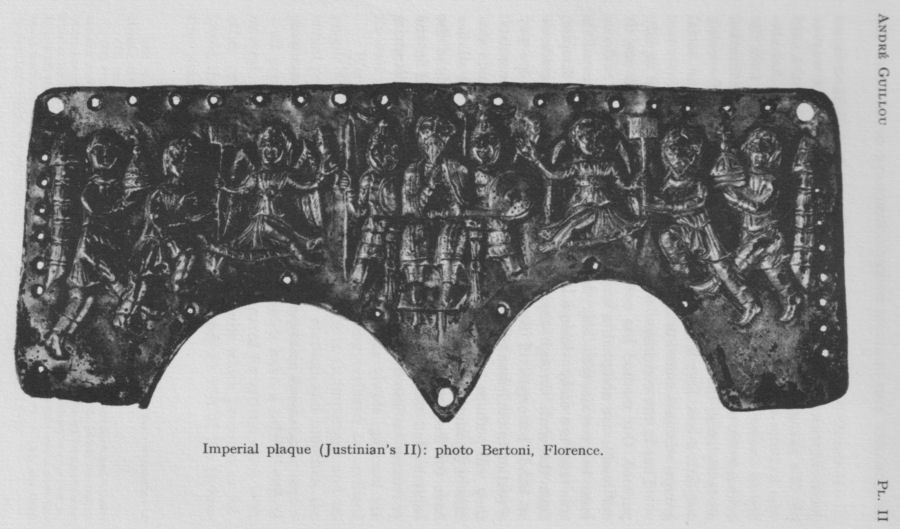
Pl. III.
Warrior on horseback: photo Gabinetto Fotografico Nazionale, Rome.
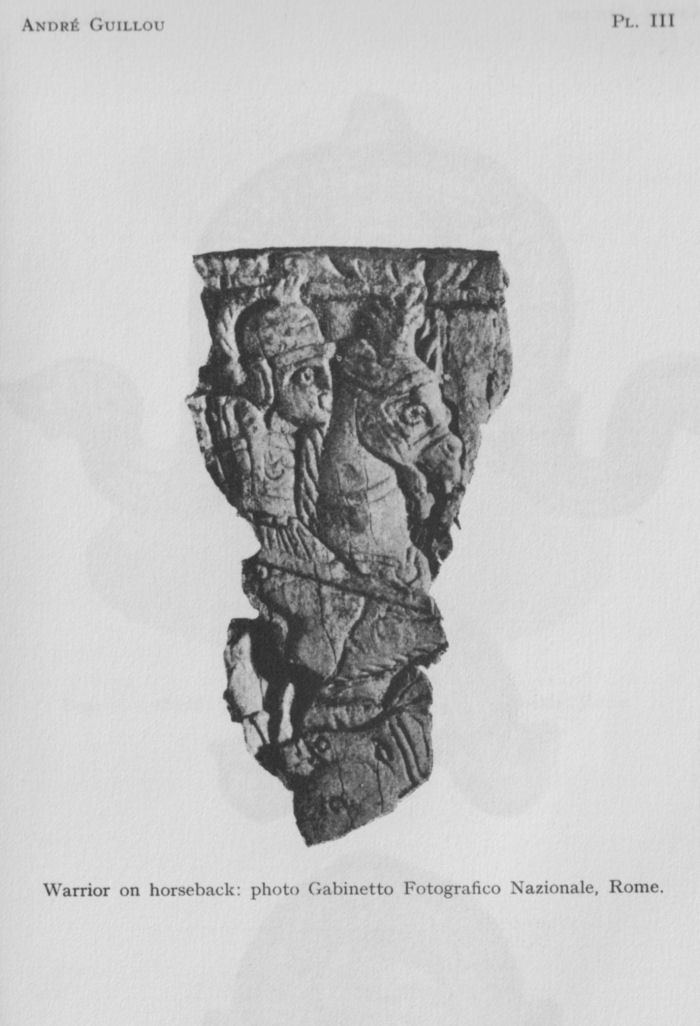
Pl. IV.
Saddle ornaments: photo Gabinetto Fotografico Nazionale, Rome.

Pl. V.
Boss of a shield: photo Gabinetto Fotografico Nazionale, Rome.

Pl. VI.
Warrior on horseback : photo Bertoni, Florence.

Pl. VII.
Lombard reliquary (from G. de Francovich, Il problema delle origini della
scultura cosidetta ‘Longobarda’, pl. V, fig. 7).
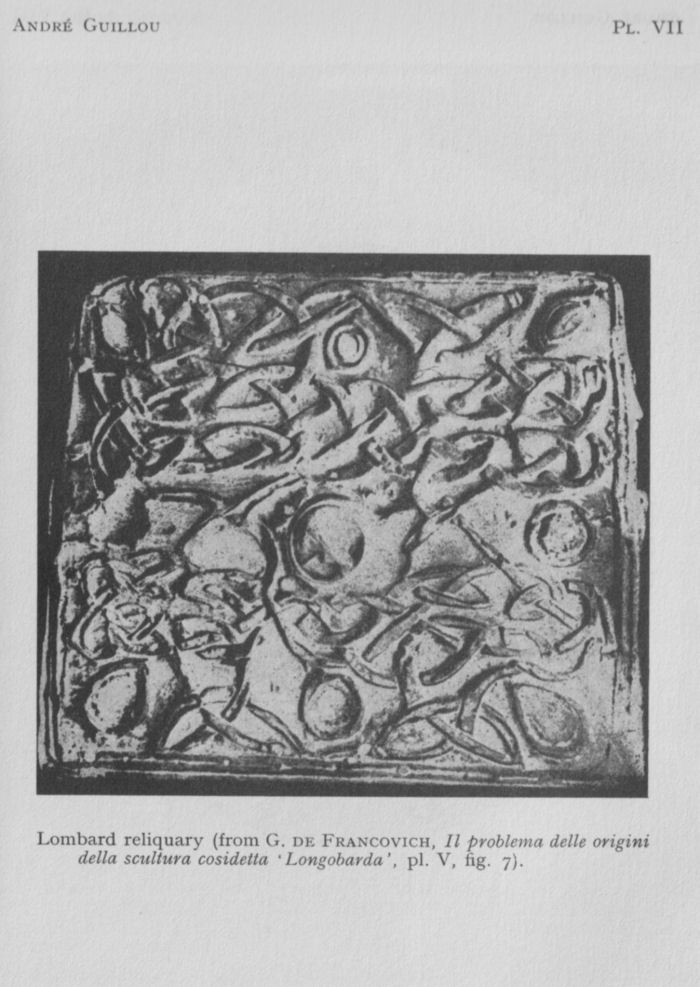
Pl.
VIII. Lombard bracteate (from C. Cecchelli, I monumenti del Friuli dal
secolo IV all’XI, I: Cividale, Rome, 1943, pl. LXX, c).

Pl. IX. Tuscania ambo: photo Alinari, Rome.

Pl. X.
Aquileia plaque (from G. de Francovich, Il problema delle origini della
scultura cosidetta ‘Longobarda’, pl. VIII, fig. 10).
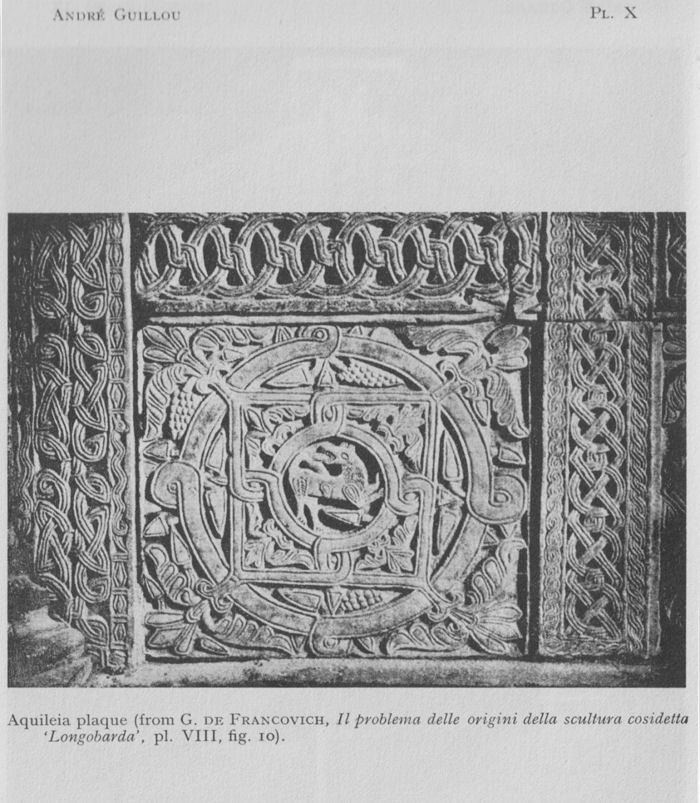
Pl. XI. Cividale plaque: photo O. Böhm, Venice.
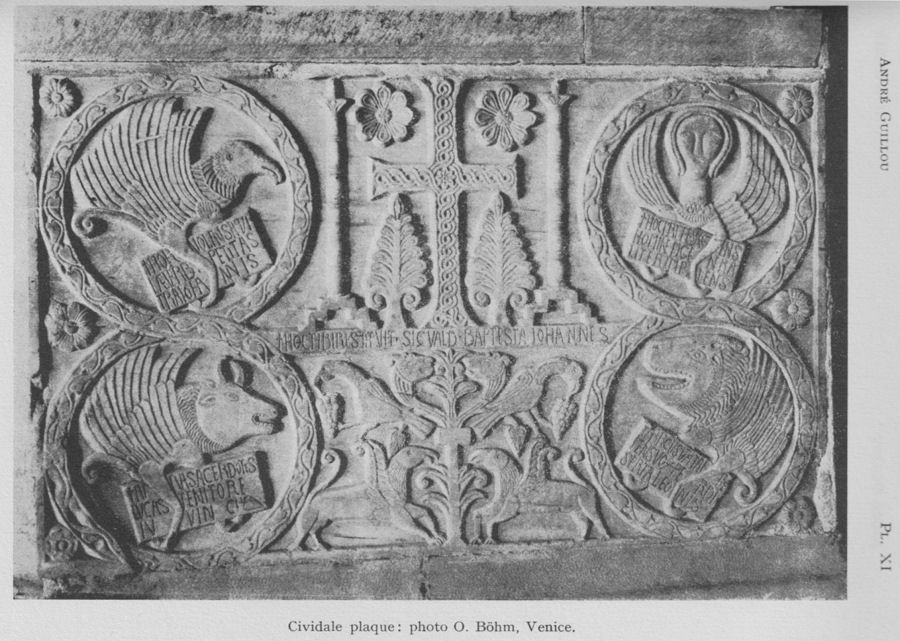
Pl. XII. Sirmione plaque (from G. de Francovich, Il problema delle origini della
scultura cosidetta ‘Longobarda’, pl. IX, fig. 11).
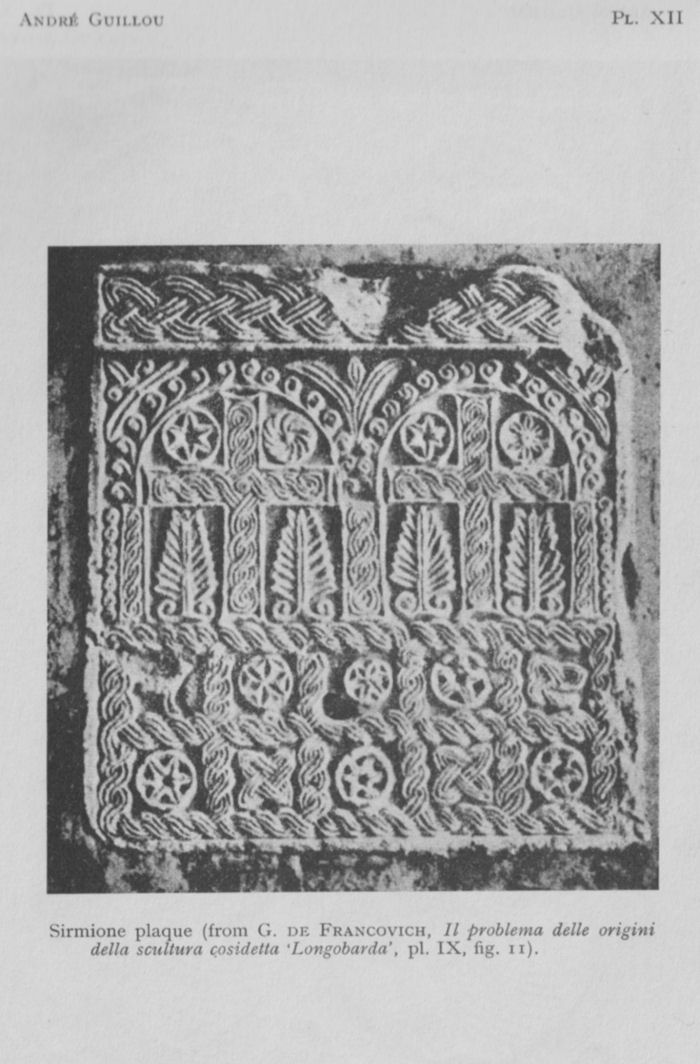
Pl.
XIII. Bronze lamp: photo Museo dell’Alto Medio Evo, Rome.
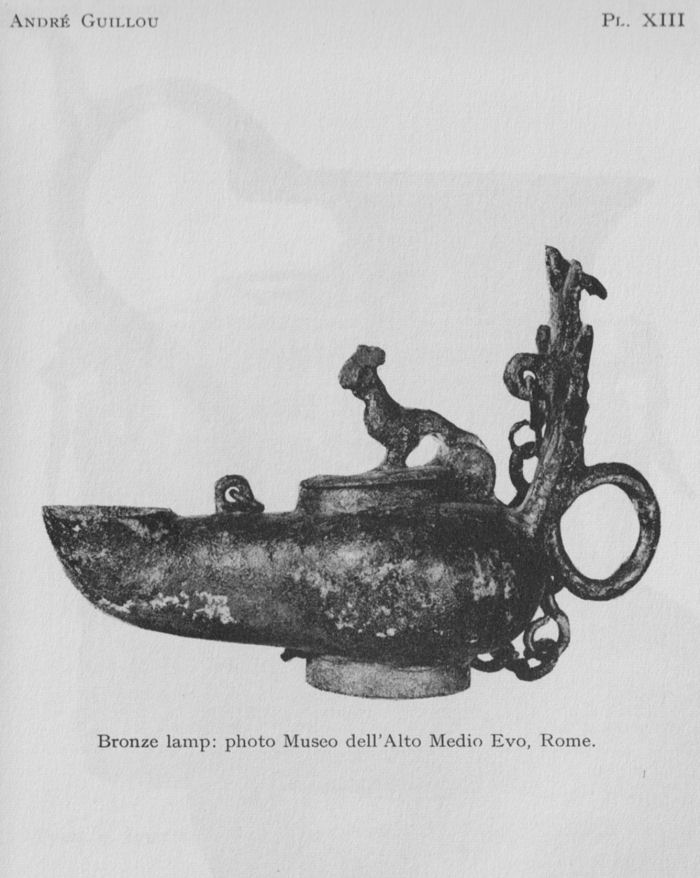
Pl. XIV.
Bronze ewer: photo Museo dell’Alto Medio Evo, Rome.
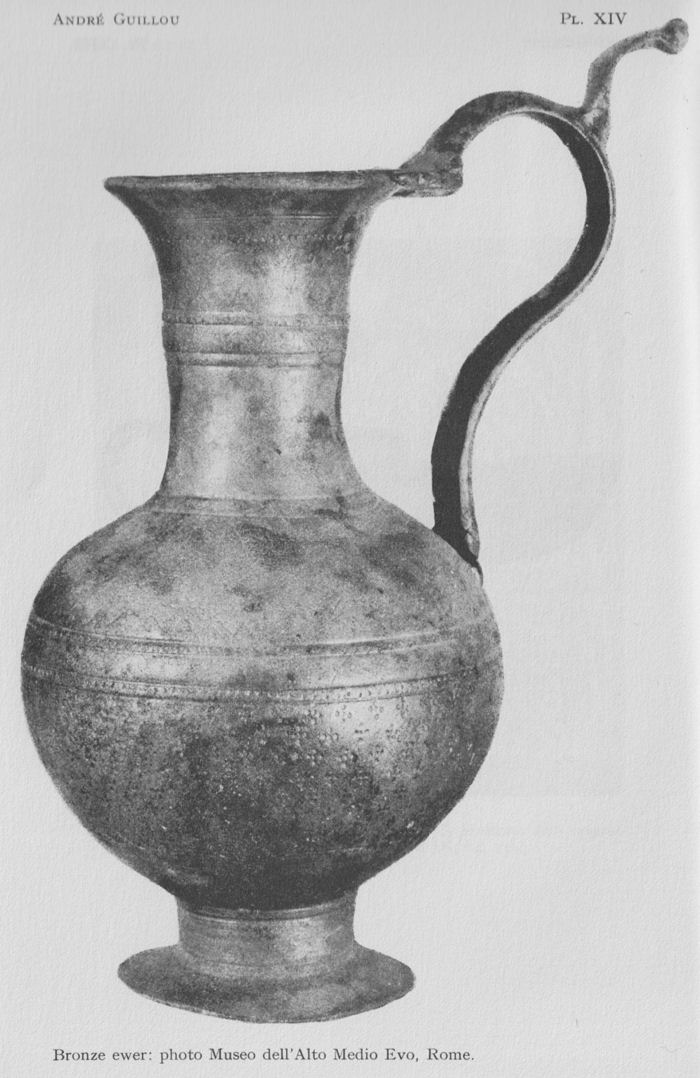
Pl. XV. Pyxis, a, Isaac sacrifice: photo Gabinetto Fotografico Nazionale,
Rome.
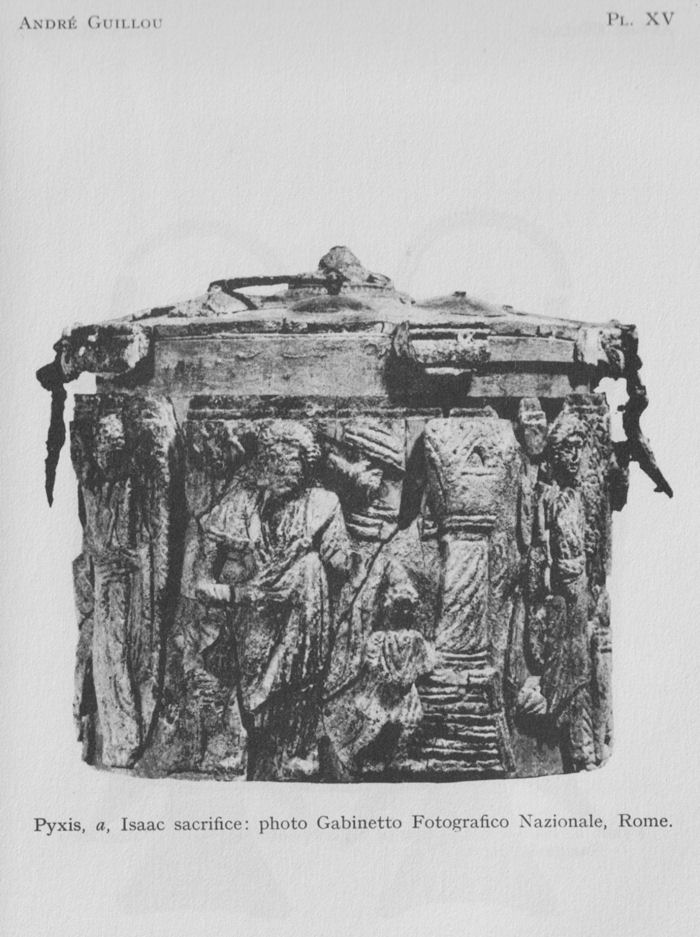
Pl. XVI. Pyxis, b, Daniel in the den of lions : photo Gabinetto Fotografico
Nazionale, Rome.
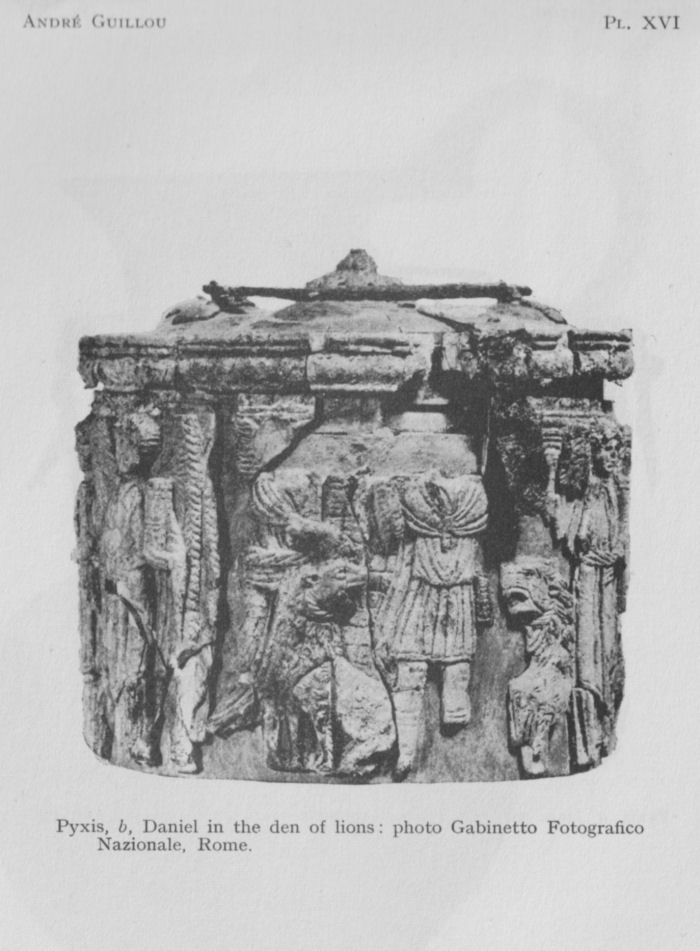
Pl.
XVII. Earrings: photo Gabinetto Fotografico Nazionale, Rome.
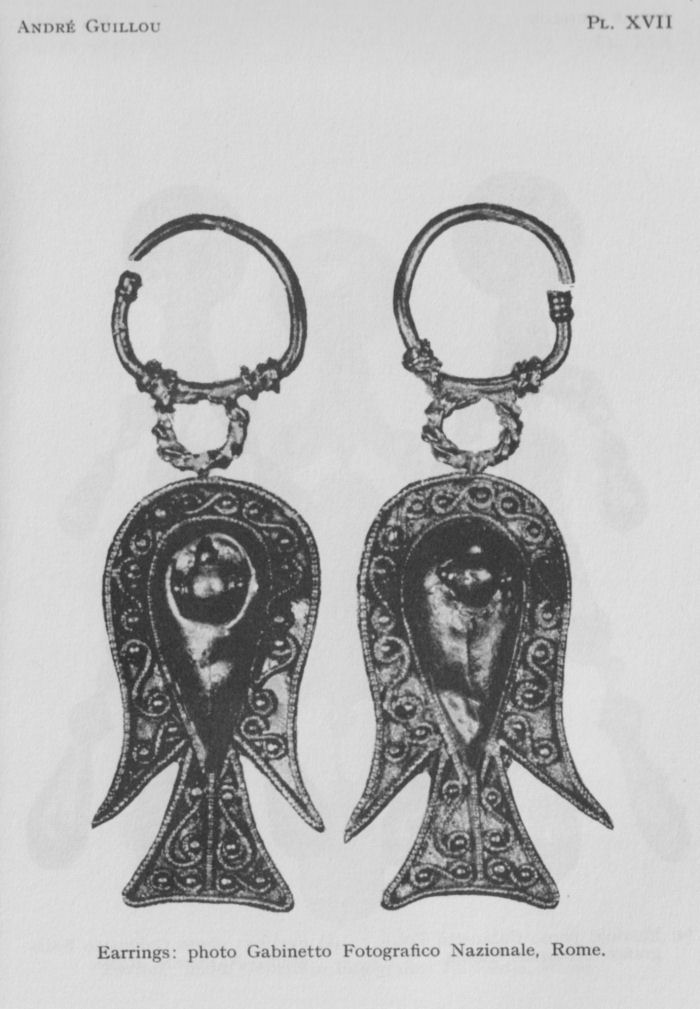
Pl.
XVIII. (a) Earring: photo Gabinetto Fotografico Nazionale, Rome. (b)
Earring: photo Gabinetto Fotografico Nazionale, Rome.
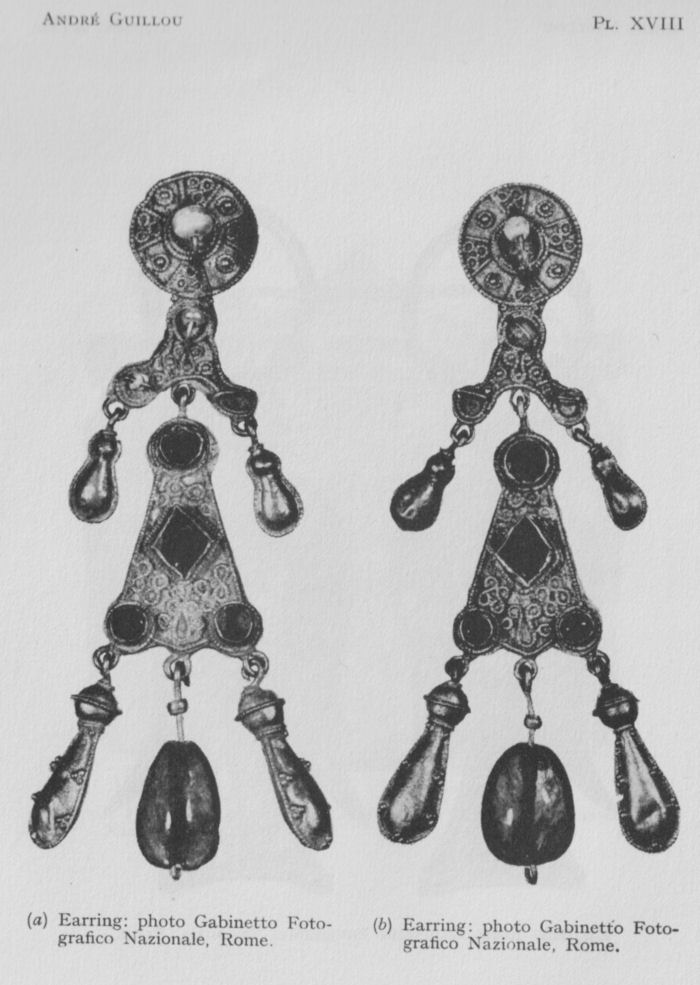
Pl. XIX.
Earring: photo Gabinetto Fotografico Nazionale, Rome.
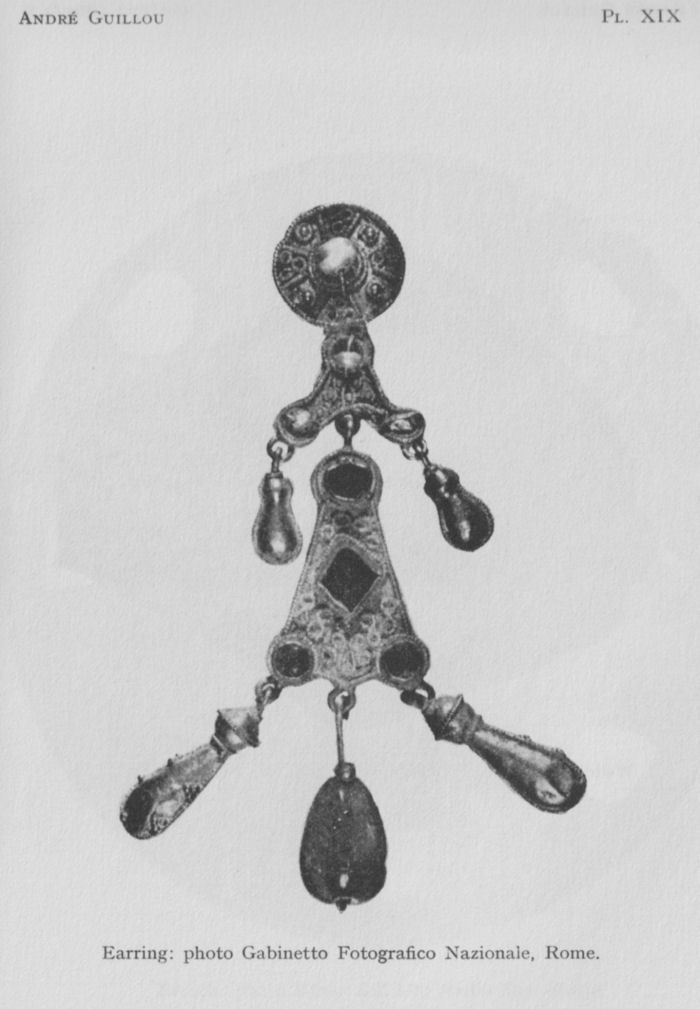
Pl. XX.
Wedding ring: photo Gabinetto Fotografico Nazionale, Rome.
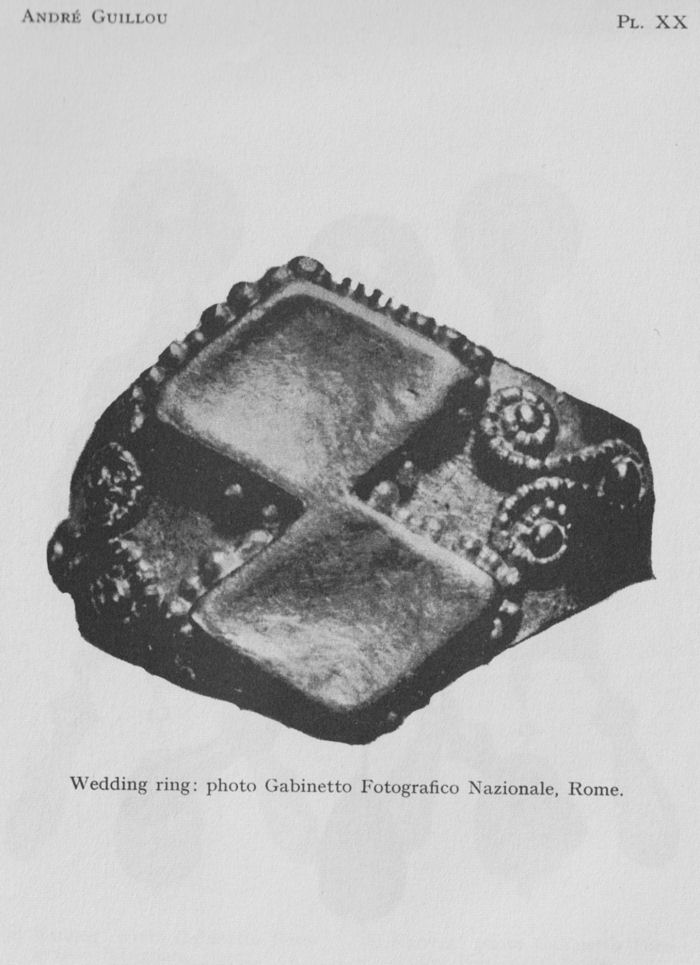
Pl. XXI.
Brooch: photo Museo dell’Alto Medio Evo, Rome.

Pl.
XXII. Brooch: photo Gabinetto Fotografico Nazionale, Rome.
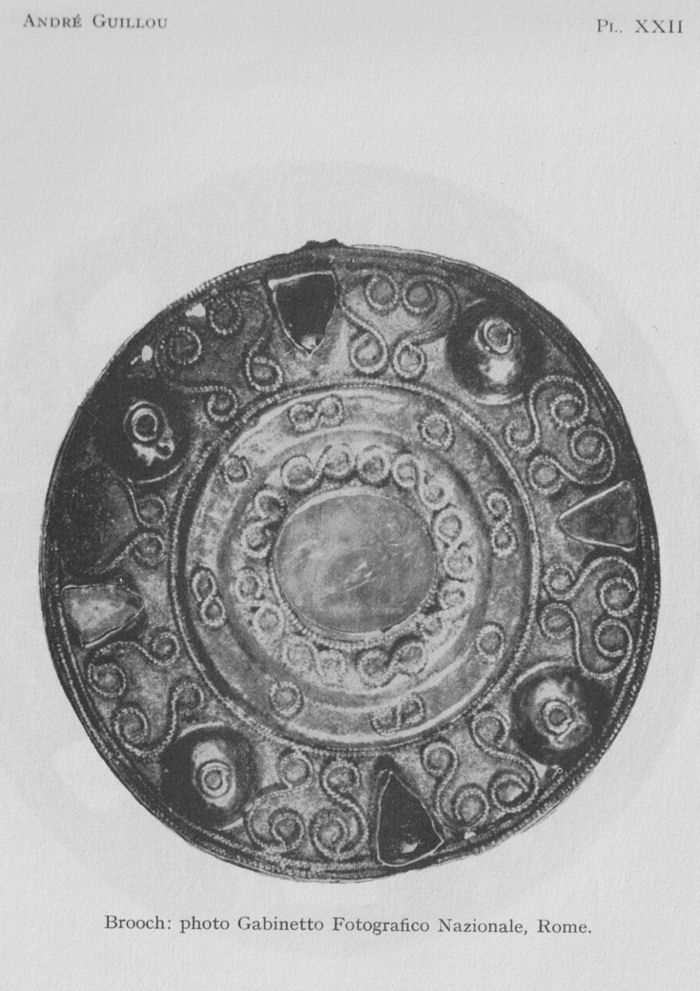
Pl.
XXIII. Brooch: photo Gabinetto Fotografico Nazionale, Rome.

Pl.
XXIV. Brooch: photo Gabinetto Fotografico Nazionale, Rome.

Pl. XXV.
Bronze basin: photo Gabinetto Fotografico Nazionale, Rome.

Pl.
XXVI. Bronze basin: photo Gabinetto Fotografico Nazionale, Rome.

